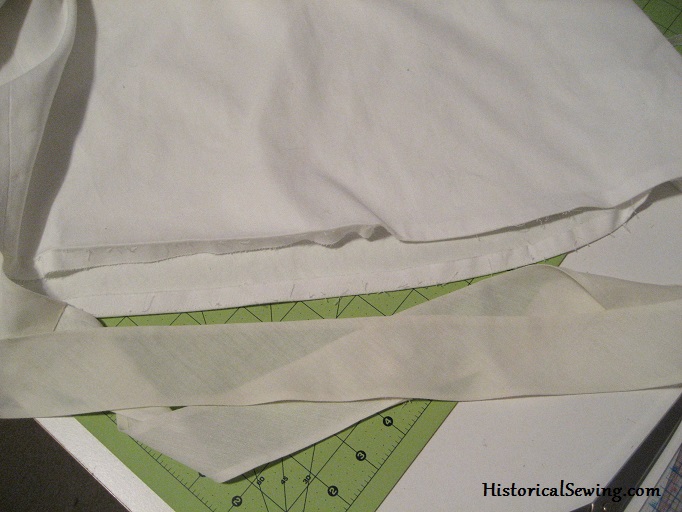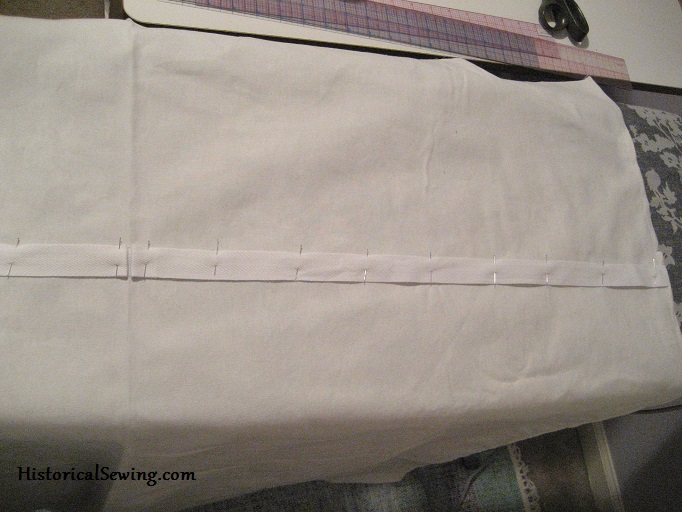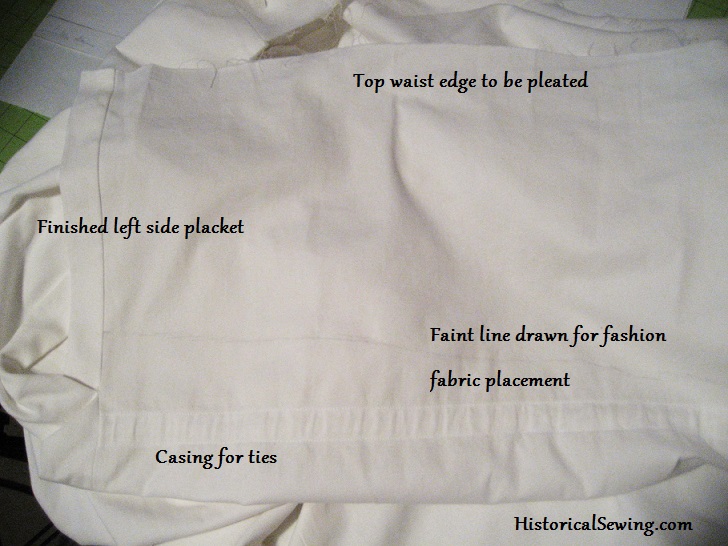
I’ve been sewing for so long (nearly 30 years!) that all the prep work that goes into a garment seems boring to me. You know… washing, ironing, sewing endless straight seams on underskirts, hems, etc….
Apparently I forget that all the work that goes into creating the foundation of the silhouette IS what’s so important in how a garment turns out.
Building a sturdy foundation is where it’s at! It’s the proper undergarments. It’s using the right fabrics to support the fashion fabrics. It’s the fit of the base skirt over the silhouette that’s a reason to write home about.

The skirt is made from cotton twill, fairly lightweight but good body for support. It is the foundation skirt to my 1887 Summer Berry Trifle dress which will, in it’s final version, be seen as only a yummy striped thing with the cotton shirting fabric shooting stripes in all directions.
It is worn over my basic undergarments and 1880s corset with the Truly Victorian TV163 Lobster Tail in Imperial Size with a simple petticoat thrown on top. (You can see these in more detail in my fairy tail story.)
The skirt itself is made from TV261 but with added length to the back to account for the larger size bustle. In my fitting I discovered I added too much back length so I’ve ripped out the hem facing and will trim the center back panel so the skirt hangs more evenly all the way around.

Since I’ve now made a huge Imperial Bustle I’ve discovered that due to my flat back side (I’m no J.Lo to be sure!) this bustle actually gives me a bustle silhouette I’ve desired for years! I never realized that not having natural “fluff” it would cause any bustle to sink. 🙁 I think I need to make more bustle pads…

Anyhow… in addition to adding length as Heather advises in the bustle pattern, I applied casings to the back panel for the top bustle ties. I simply noted where the ties sew on (right below the placket opening) and drew a straight line across the full back panel.
The casings are 1″ cotton twill tape. The opening is at center back for the ties to draw up the skirt width. This helps keep the full skirt panel shaped over the large bustle frame.

This is what the top of the skirt looks like without the ties drawn. I’ve yet to apply the waistband as the overskirt will be basted on first so as to have one complete skirt.
So now that I have a foundation skirt that pleases me for the look I want, my next step will be to apply the stripe fabric horizontally at the drawn on hip line then mount the overskirt panels over that and set on the waistband. Can’t wait to get to the colors! (Read about the finished dress here.)
Do you find yourself bored with foundations? Do you see the importance of building a solid silhouette and how it affects the rest of the dress?
(Thanks to Debra K. for this very appropriate and fun blog post title!)

Do you have any tutorials or classes that cover the Truly Victorian 1885 Eton Bodice (TV468) and the Truly Victorian 1884 Wash Overskirt (TV362)? I have purchased your Victorian Day Bustle Dress and the lack of detail in the pattern instructions have me perplexed. I consider myself an intermediate-level sewer. Please let me know if you are aware of any resources.
Hi Kelly. I don’t specifically have full tutorials on those patterns. I have made the wash skirt, though. You are welcome to post your questions within the Day Dress class and I can help you there.
I have the opposite problem as you, Jennifer. I have so much junk in my trunk that it’s hard to get the bustle and/or cage crinoline to fit properly at the hips. I had to re-engineer the TV elliptical hoop about 10 times before it fit properly! It’s easier in historical costuming to have none and create some than to have too much and try to work around it, haha.
Oh, I agree!
I love to see close-ups of actual garments from the period! Thanks so much! 😀
It is so nice to see exactly how you are doing this…I really appreciate it….reading directions in a book are just not the same thing 🙂
What, in your opinion, is the best fabric to line an 1860s day dress/walking dress under taffeta? Would any kind of cotton do?
Muslin or polished cotton are best. You can see an original cotton lining a taffeta bodice here.